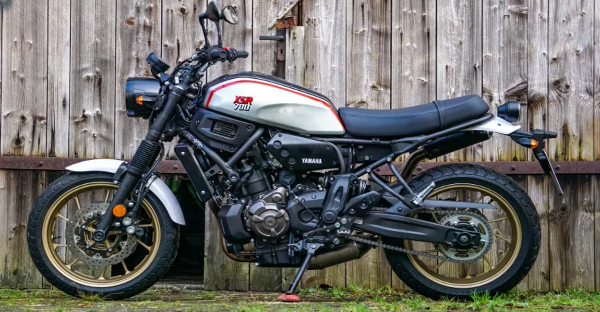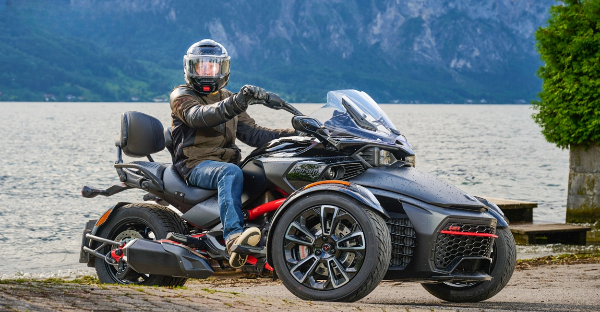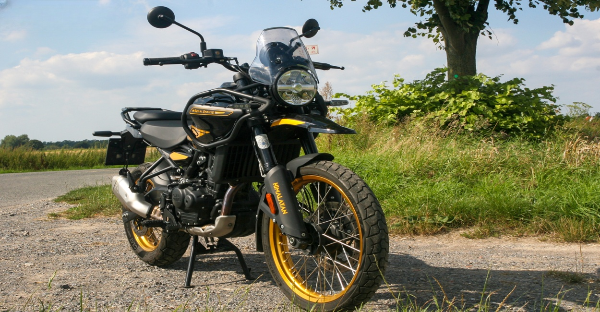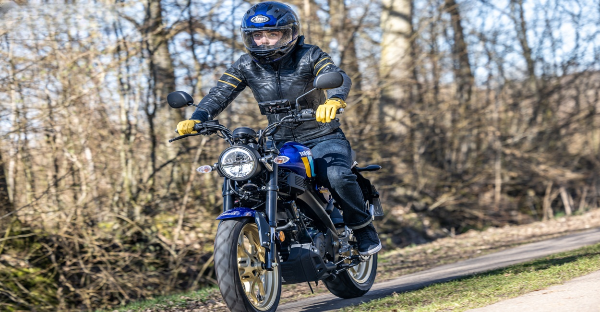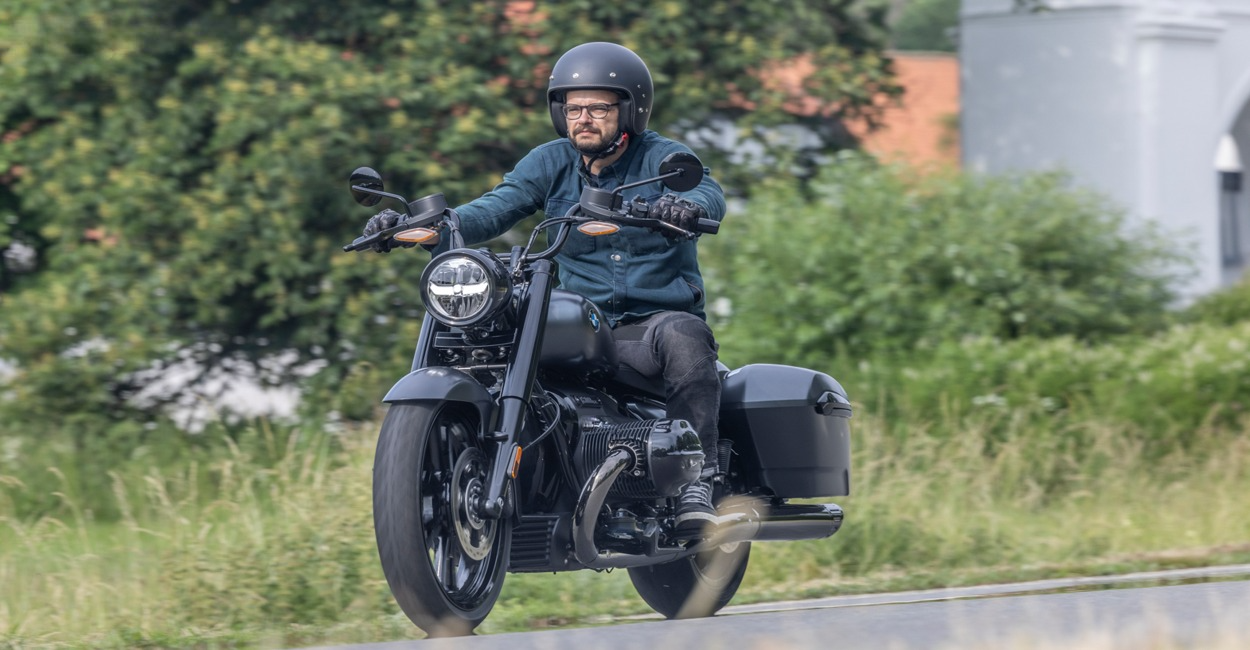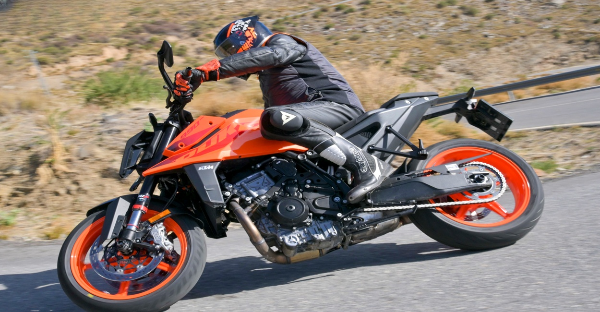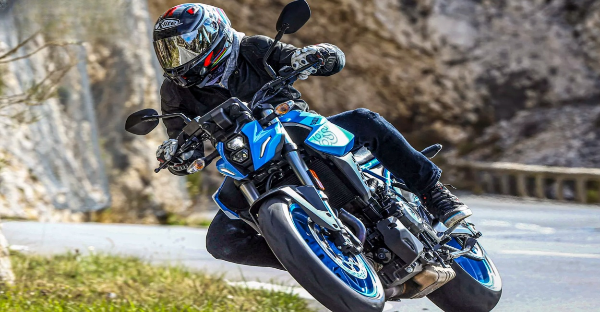Keylong. A name that echoes quietly in the folds of the Himalayas, somewhere beyond Manali, past the Rohtang snowcaps, and far from what most would call “riding weather.” Up here, winter doesn’t just visit, it claims the land. And this was exactly where I decided to put the Yamaha XSR700 XTribute to the test. A motorcycle born of retro soul and modern spirit, and perhaps foolishly, I asked it to be my companion through a Himalayan winter ride, naked, unfaired, and unapologetically old-school. No heated grips. No traction wizardry. Just raw metal, a roaring engine, and layers of fabric between me and a landscape that tests more than just man or machine,it tests your will.
Light, Pure, Cool
I met the XSR700 XTribute at Yamaha’s lot in Neuss. It was like staring at a remix of the past, a knowing nod to the legendary XT500, wrapped up in modern skin. Matte gold spoked wheels. Chunky tires. A brushed aluminum-look tank kissed with red accents. And somehow, in its simplicity, the bike looked… cool. Not “Instagram cool,” but proper, honest-to-metal, café-sidewalk cool. Marvin from Yamaha handed me the key and simply said, “She’s light. That’ll matter.” He wasn’t wrong. At 188 kilograms fully fueled, the XSR feels featherlight, especially when you’re manhandling it across icy parking lots or doing a boot-slide at a roadside stall. The seat height of 835 mm allowed me, at 5’10”,to comfortably get both boots on the ground even on uneven Himalayan dirt. And when I rolled it out of the hotel in Keylong at sunrise, snow dusted along the roadside, the XSR didn’t flinch.
No Technical Frills
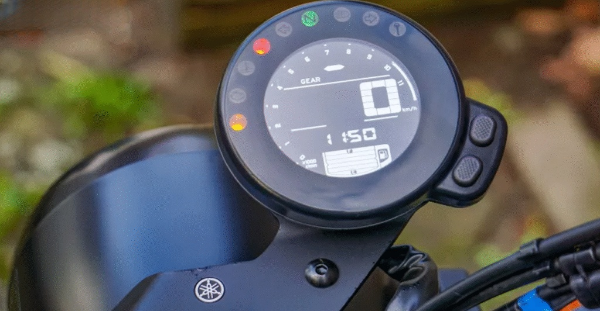
The thing about riding through Keylong in January is that it removes the luxury of gimmicks. When you’re contending with frosted visors, frozen fuel nozzles, and the kind of wind that howls through your bones, you start appreciating honesty. And the XSR700 XTribute is nothing if not honest. There’s no traction control. No electronic suspension. No cruise modes. No TFT dash with widgets. Just a clean, circular instrument pod that tells you everything you need, speed, rpm, fuel, time, and nothing more. ABS is there, but unobtrusive. The engine is Yamaha’s brilliant CP2 twin-cylinder, 689cc, 75 horsepower at 9,000 rpm, and 68 Nm at 6,500 rpm. The power delivery is linear, the throttle response instant, and the gearbox, like clockwork. Even when climbing the roads to Sarchu in sub-zero chill, the XSR700 never once felt unsure of itself. There’s something liberating about knowing that what’s underneath you isn’t second-guessing every move. It lets you ride.
Making Distance is the Order of the Day
Leaving Keylong meant one thing: distance. The vast, cold vacuum of Lahaul. The CP2 engine hummed to life without hesitation even at near-zero temps. First gear. Smooth. Second. Third. I hit 80 km/h within seconds on a narrow straight, and that sweet, gruff Akrapovič note began to sing, subtle at idle, delicious under throttle. I was aiming to reach Manali before dark. That’s over 100 kilometers through terrain that shifts between black ice and slush. On the straight stretches, the XSR felt like a middleweight roadster in its prime. The torque curve is meaty where it needs to be, pulling hard at low revs, easing into a buttery midrange. It’s never aggressive, but it’s never lazy either. Like a dog bred for the hunt, always alert, always willing.
By 80 kilometers, my gloves were done. The XSR? Still warm.
I’m telling you, there’s no gear on Earth that can save your fingertips from Himalayan cold forever. Somewhere past the 80 km mark, my winter gloves just gave up. The cold started creeping in like little knives stabbing at my knuckles. I had to pull over at a tiny tea shack near Koksar, rip them off, and swap in a bulkier pair I had stashed in my bag.
Heated grips? Yeah right. This is the XSR700 XTribute. There’s no tech wizardry here. Just me, the throttle, and my stubborn will to keep moving forward. I started folding my fingers into my palm while riding, just to squeeze some warmth in. Probably looked like an idiot doing it, but I didn’t care. Because underneath me, that CP2 engine was still purring, throwing off this subtle heat, like a little campfire you can feel through your boots. That’s when I knew, I could trust this machine.
Three layers weren’t enough when riding XSR700
I was already layered up, base thermal, fleece-lined inner, and my usual textile jacket. Thought I was good. Then Rohtang Pass hit me with a gust that felt like it came straight from the Arctic. At the next fuel stop, I threw on my rain gear, not for rain, but to block the wind. It helped. Mostly.
The XSR700’s riding position is upright and relaxed, which is perfect for tight switchbacks and open views, but it means you’re taking the full hit from the wind. Still, I’m not complaining. This isn’t some wind-tunnel-shaped race bike. It’s a proper retro scrambler. The wide handlebars gave me solid control, the footpegs were just where they needed to be, and honestly, the suspension soaked up the broken Himalayan roads like it was born there. I wasn’t just riding a bike, I was dancing with the cold, and the Yamaha never missed a step.
Performance of bike inside tunnel
Okay, so no Elbe Tunnel here. But I had my own version, Atal Tunnel. 9 kilometers of relative warmth at 3,000 meters. Suddenly, the XSR felt like it gained power. My visor stopped fogging. I took a deep breath. The contrast was poetic, outside, an unforgiving chill; inside, the warmth of technology and tarmac. I smiled inside the helmet. The Yamaha didn’t change, it was always good. I was just noticing it more now, through thawed fingers and a relaxed spine.
The Instrument Shines Like a Searchlight
The circular dash is classic in look but backlit like a modern beacon. At night, it glows bright white, almost too bright. I found myself shading it with my glove at times. But in foggy stretches near Sissu, that backlight became a blessing. I didn’t miss a thing. Speed? Check. Fuel? Still half a tank, impressive for the revs I’d been pulling. Tripmeter told me I’d crossed 280 kilometers without fuss. No flickering, no warning lights, no complaints from the bike. Just the quiet hum of reliability.
In the End, the Good Feeling Counts
Somewhere past midnight, I parked in Manali. My boots were damp, my fingers numb, and I reeked of exhaust and chai. And yet, I felt alive. The XSR700 XTribute had taken a bone-cold, 400+ kilometer Himalayan ride and turned it into a memory I’d gladly revisit. Sure, I’d sung to myself inside the helmet, cursed the wind, and nearly cried into a gas station samosa. But the bike never once let me down. There’s something deeply satisfying about a machine that doesn’t ask for much but gives you everything, comfort in simplicity, thrill in honesty.
Technical Specifications
| Component | Details |
| Engine Type | 689cc, liquid-cooled, 4-stroke, DOHC twin-cylinder |
| Bore x Stroke | 80 x 68 mm |
| Compression Ratio | 11.5:1 |
| Maximum Power | 75 hp (55 kW) @ 9,000 rpm |
| Maximum Torque | 68 Nm @ 6,500 rpm |
| Transmission | 6-speed manual |
| Clutch | Multiplate wet clutch |
| Final Drive | Chain |
| Frame | Diamond-type tubular frame |
| Front Suspension | Telescopic fork, 130 mm travel |
| Rear Suspension | Swingarm with link-type monoshock, 130 mm travel |
| Front Brake | Dual 282 mm discs, ABS |
| Rear Brake | 245 mm disc, ABS |
| Tires | 120/70 ZR17 (front), 180/55 ZR17 (rear) |
| Wheelbase | 1,405 mm |
| Seat Height | 835 mm |
| Fuel Tank Capacity | 14 liters |
| Weight (wet) | 186 kg |
| Fuel Consumption | ~4.3 L/100 km |
| CO2 Emissions | 99.8 g/km |
| Emissions Standard | Euro 4 |
| Price (approx.) | €8,174 |
Conclusion
The Yamaha XSR700 XTribute isn’t a bike made for winter. But it didn’t care. Neither did I. It just rode. Through frost, fog, and mountain tunnels. It reminded me that the best rides aren’t the comfortable ones. They’re the ones that challenge you, and leave you with a story you’ll tell for years. This bike is for purists. For the riders who don’t care about dash graphics or cornering ABS. It’s for those who crave connection. Steel to spine. Rubber to road. Soul to saddle. And up there in Keylong, in the dead of winter, I found all three.
Is the Yamaha XSR700 XTribute comfortable for long rides?
The flat seat and upright ergonomics offer a relaxed riding posture. However, for long touring days, you might want to consider adding a comfort seat or windscreen accessory.
Does Yamaha XSR700 XTribute come with modern features?
It comes with ABS, LED lighting, and digital instrumentation. However, it doesn’t feature advanced electronics like traction control, riding modes, or a TFT screen, in keeping with its retro ethos.
What are the color options available?
As of the latest model year, the XSR700 XTribute comes in a unique retro-inspired silver color scheme with black and gold detailing, mimicking the classic XT500.
